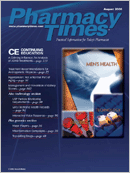Publication
Article
Pharmacy Times
A Pharmacist's Guide to OTC Therapy: Treating Tinea Pedis
Author(s):
There are a variety of nonprescription products currently on the market for the self-treatment of tinea pedis (dermatophytosis of the foot), commonly referred to as athlete's foot. Many consumers suffer from the discomfort of tinea pedis, whose characteristic symptoms include dry, cracked skin, constant itching, inflammation, scaling, and painful burning sensation. The goals of therapy for treating fungal infections such as tinea pedis include providing adequate relief of symptoms experienced by the patient, eliminating the presence of the infection, as well as educating the patient on preventive measures that reduce or eliminate future infections.
Nonprescription Treatment Options
Nonprescription products available for the treatment of fungal infections contain imidazole derivatives, such as clotrimazole and miconazole. In 2001, butenafine became reclassified as a nonprescription product and is currently marketed as the brand Lotrimin Ultra cream (Schering-Plough HealthCare Products Inc). Other products may contain tolnaftate, which is the only nonprescription ingredient approved for both the prevention and treatment of athlete's foot.1 These products are available in dosage forms which include creams, sprays, powders, and liquids (Table).
Management
In general, patients can effectively manage tinea pedis when they incorporate pharmacologic and nonpharmacologic measures into the treatment plan. In general, patients should be advised that relief is usually seen within 1 week of therapy. Patients should be reminded to continue therapy for the recommended duration of time, however, to ensure that the infection is treated properly and to incorporate nonpharmacologic means of preventing tinea pedis into their daily routine in order to deter or reduce the incidence of future infections.
The majority of mild cases of athlete's foot can be effectively treated with the use of the many nonprescription products available on the market. Prior to recommending any of these products, pharmacists should assess each case and determine if self-treatment is appropriate or if further medical evaluation is warranted, such as for individuals with diabetes or circulatory conditions and patients who may be considered immunocompromised.1
Patients should also be reminded that infections that do not appear to be responding to the use of self-care products should be evaluated by their health care provider for further assessment and to prevent further complications.
Yvette C. Terrie, BSPharm, RPh Ms. Terrie is a clinical pharmacy writer based in Haymarket, Va.
For a list of references, send a stamped, self-addressed envelope to: References Department, Attn. A. Rybovic, Pharmacy Times, Ascend Media Healthcare, 103 College Road East, Princeton, NJ 08540; or send an e-mail request to: [email protected]

Newsletter
Stay informed on drug updates, treatment guidelines, and pharmacy practice trends—subscribe to Pharmacy Times for weekly clinical insights.






